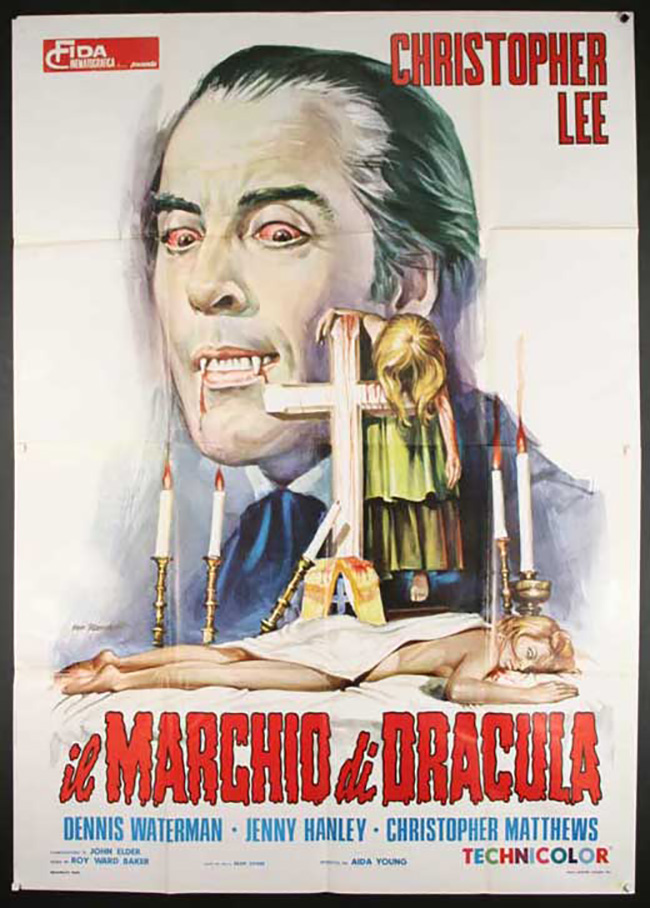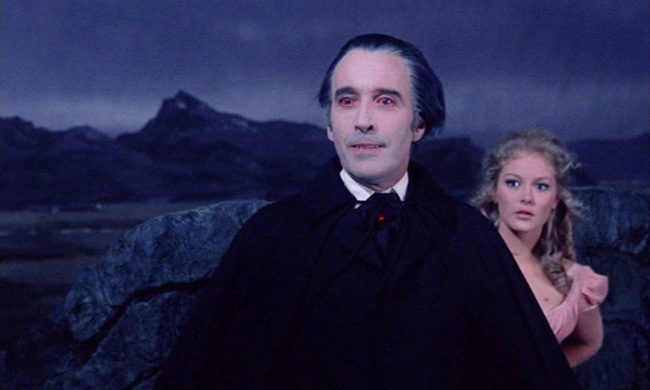
Following hot on the heels of Hammer’s Taste the Blood of Dracula (1970), in which Christopher Lee was just barely convinced to pick up Dracula’s cloak once more, Scars of Dracula (1970) was conceived as a double bill with a new Frankenstein picture (the failed reboot Horror of Frankenstein) to try to revive the studio’s fading fortune. With American financing having dried up, Sir James Carreras – soon to walk away from the studio he’d once ushered to great success – turned to the Associated British Picture Corporation (ABPC), recently taken over by EMI; the resulting films had a much lower budget, and it showed. Roy Ward Baker, who had just directed the exploitation classic The Vampire Lovers (1970) as part of Hammer’s short-lived deal with American International, was handed the reins to the Dracula film; screenwriter Jimmy Sangster directed the Frankenstein. The two pictures made for an irresistible poster, but the films themselves were weak tea compared to Hammer’s glory years – a troubling sign as the studio entered its most fraught decade. A Region B Blu-ray from StudioCanal, part of the company’s new wave of Hammer releases, offers fans an opportunity to reassess with an attractive and colorful HD presentation. The film still compares poorly to other entries in the long-running Dracula series, but its virtues sit alongside its flaws so equally that depending on your mood, Scars of Dracula is either abysmal or a guilty pleasure – a fun, bloody bit of Gothic sleaze. My opinion flips each time I watch it, and this time, I admit, I was a bit more favorable.
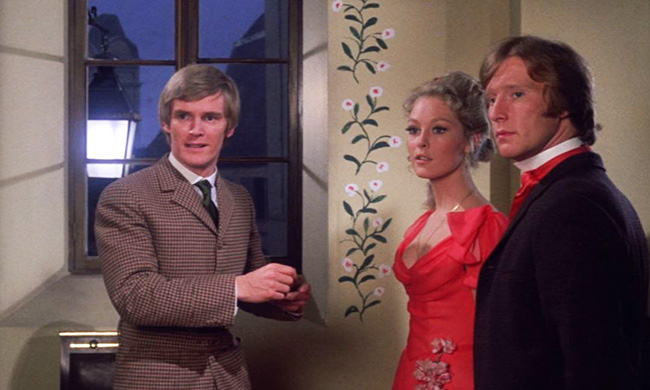
Paul (Christopher Matthews), fleeing the Burgomeister’s men, drops in on his brother Simon (Dennis Waterman) and Simon’s squeeze Sarah (Jenny Hanley).
Unusually, the film dispenses with one of the most enjoyable aspects of the franchise: it does not pick up where the last one left off (which was merely Dracula collapsing in a church, so it’s no big loss). Still, Dracula is in a state of dissolution once again, and is immediately, improbably revived by a giant vampire bat that spills blood out of its lips onto Dracula’s powdered body. This bat, and his bat brethren, are practically main characters in Scars, so it doesn’t help that they’re far too phony looking to appear in a film made in 1970. Dracula is soon feasting on the neighboring villagers; the “scars” of the title appear over an image of one of his victims and the bite marks on her neck, though we will later come to see other, more sadistic kinds of physical scars left by the Count. (The film’s literal-mindedness makes it fruitless to apply a metaphorical interpretation of the title.) The angry villagers, led by a priest (Michael Gwynn, Village of the Damned), storm Dracula’s castle, attack his servant Klove (Patrick Troughton, the second Doctor Who) and set fire to the place, leaving it in ruins. Later, we meet Paul (Christopher Matthews), who’s sleeping with the Burgomeister’s daughter (Delia Lindsay), a bawdy misadventure that eventually throws him into a carriage carrying him away toward the mountain village in the shadow of Dracula’s castle. Hammer mainstay Michael Ripper plays a tavernkeeper (of course) who turns him out in the middle of the night, leaving Paul with no choice but to seek the castle for shelter. He’s greeted by a warm and surprisingly chatty Dracula, one more in line with the character who greeted Jonathan Harker in Bram Stoker’s novel than the often-mute persona of evil Lee usually portrayed. Paul is seduced by one of Dracula’s mistresses (Anouska Hempel, On Her Majesty’s Secret Service), and meets his fate when he discovers Dracula’s secret crypt, whose only door is in the sheer face of the castle wall. As with Psycho, our main character is abruptly offed and it’s left to a young couple to go looking for him: his brother Simon (Dennis Waterman) and Simon’s girlfriend Sarah (Jenny Hanley, The Flesh and Blood Show).
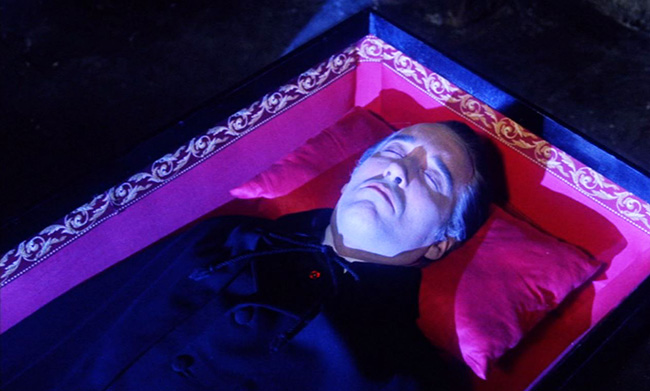
Dracula (Christopher Lee) at rest in his crypt.
It’s no secret that although Hammer’s Dracula films have inspired a loyal and enthusiastic following over the decades, their storylines and characterizations often pale in comparison to the more fascinating Frankenstein films of Peter Cushing. Scars of Dracula is no exception, unless you are to compare it directly to its counterpart Horror of Frankenstein, a series low point. Though I love the Dracula franchise, I’m still baffled that the screenwriters time and again applied so little imagination. Writer and Hammer exec Anthony Hinds has his pseudonym (John Elder) on the script, and as a result it maintains a certain standard of quality, but it is also out of ideas…with one exception: a welcome return to Stoker’s source novel, which surely appealed to Lee. The castle-bound Dracula is allowed to be a gentleman again, showing his feral side (and bloodshot contact lenses) only when he feasts or exacts his revenge. Baker, studying the novel, insisted his film also contain the book’s surreal image of Dracula scaling the castle wall. If there is one aspect of the film I truly love, it is the notion that Dracula’s crypt is inaccessible to anyone who is not a vampire or a bat (and this is the sole matte painting in the movie that actually looks good); the image of Paul descending toward the crypt by bedsheet is a great deal of fun, and when Simon gets stuck in this dank room near the climax, there’s a genuine feeling of peril. Elsewhere, Troughton’s portrayal of the servile Klove is interesting because the depraved man becomes more sympathetic as the story moves along. Fixated by a portrait of Sarah in a stolen locket, he is moved to save her life and Simon’s; only later do we see him turn against Simon, as it’s the girl he truly wants. There’s also the fact that Klove’s relationship with his master has a trace of homoerotic S&M, as he willfully exposes his scar-laced back, asking Dracula to punish him for his transgressions.
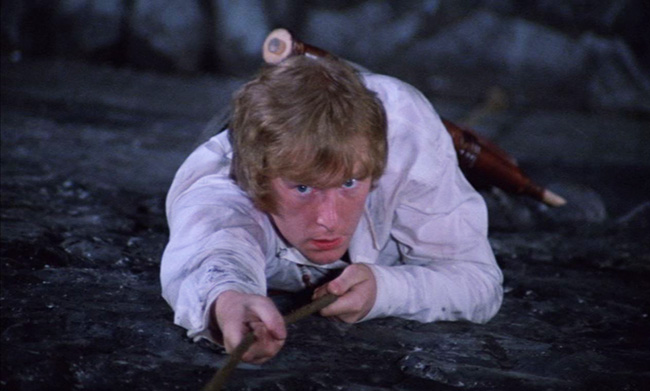
Simon descends the castle wall.
This being a 1970’s Hammer film, proceedings are more graphically portrayed. Vampire bats – who don’t seem to be at Dracula’s control so much as acting as his gleeful co-conspirators – slaughter villagers taking shelter in a church in one sequence, blood splashed against the walls, Baker’s camera zooming in on ripped flesh. Dracula enacts his rage on Anouska Hempel by stabbing her over and over with a knife; the BBFC had the resulting scene cut which showed him drinking from her wounds. Hanley’s ample cleavage, which takes a starring role in the final reels, is at one point mauled by a bat (trying to rip a cross necklace away from her); she spends the climax with her breasts scratched bloody. There’s even a bit of gratuitous nudity early in the film, though it is nothing compared to The Vampire Lovers (or the many sexploitation films that were arriving in seedy British theaters). Yet there is a tackiness to the film which can’t be overcome, most obviously in the scene of Dracula’s demise. These requisite climactic moments are usually pretty disappointing in anything made after Dracula Has Risen from the Grave (1968), but Scars features the worst of them all: Lee, holding an iron spear, is struck by lightning, swapped out with a stuntman in a phony-looking mask who’s set on fire, wobbles about in slow-mo, is replaced once more with a stationary dummy, and finally by what seems to be a lit match flung off a miniature castle. Over this I would gladly take Dracula being surprised by stained glass windows and falling off a balcony (Taste the Blood of Dracula) or being defeated by a bush (The Satanic Rites of Dracula). Astonishingly, this kitschy climax and the ending credits are accompanied by one of composer James Bernard’s very best scores. Bernard always rose to the occasion, and the swooning theme for Scars of Dracula might as well belong to a Romeo and Juliet adaptation. You have this, and you have Lee giving a more enthusiastic-than-normal performance, so I can’t complain too harshly when it comes to Scars. Anyway, soon Hammer would be forced to become a bit more imaginative when it came to their most famous monster – by transporting him to 1972 London.
